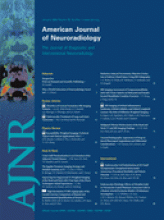I read with interest the review article by Drs van Rooij and Sluzewski1 and have some comments. Despite their goal to review therapeutic strategies for large and giant aneurysms, they ignored or had few comments regarding their growth mechanisms, which are essential in deciding appropriate treatment. Our knowledge of intracranial aneurysms has evolved from considering them as a focal and intraluminal disorder to seeing them as a complex condition involving arterial walls, extraluminal environment, and a long sequence of biologic events. The concept of aneurysmal vasculopathies was developed and a classification based in physiologic mechanisms was proposed to convey this complexity.2–5
Large and giant aneurysms are a different group of lesions and have to be considered as specific entities if they harbor partial thrombosis. The role played by the vasa vasorum, inflammation, and focal mural dissections in their pathogenesis is supported by clinical, pathologic, and biologic studies. Krings et al5 reported 21 patients who had partially thrombosed aneurysms and acute hemorrhages on MR imaging or CT. In all patients, the hemorrhages were distant from the lumen of the aneurysms and within their thrombosed portions, resulting in the typical onion skin appearance. Eighteen aneurysms had strongly enhancing walls (presumably due to the vasa vasorum and inflammation), and 17 had surrounding edema (a manifestation of extraluminal inflammatory activity).
Teng et al6 reviewed MR images of 10 giant aneurysms that showed evidence of acute hemorrhage within the mural thrombus and away from the lumen in 9. Back in the 1980s, Schubiger et al7,8 suggested that partially thrombosed aneurysms could be the result of recurring dissections due to subadventitial rupture of the vasa vasorum. Yasargil9 noted, on surgical exploration of partially thrombosed aneurysms, a network of fine vessels representing the vasa vasorum or angiogenesis induced by hematoma. Katayama et al10 reported a patient in whom a completely thrombosed giant aneurysm (no patent lumen on angiography) grew. Iihara et al11 described the growth of a giant aneurysm after occlusion of the parent artery, requiring subsequent surgery, which showed proliferation of the vasa vasorum around the neck and parent artery. Atlas et al12 observed, in 2 histologic specimens, macrophages in the aneurysm walls, emphasizing the role of inflammation. More recently, Zhao el al13 found that these macrophages contain an enzyme involved in the inflammatory cascade (5-lipoxygenase).
In light of this evidence, one may consider that partially thrombosed aneurysms are related to subacute or chronic dissections and repeated intramural hematomas, proliferating vasa vasorum, and triggering of inflammatory mechanisms. In others words, they are extraluminal disorders rather than luminal ones. The growth of large nonthrombosed aneurysms, such as serpentine or dolichoectatic ones, does not share the same mechanisms.3
Drs van Rooij and Sluzewski1 did not analyze any of the above and classified all giant aneurysms as intraluminal disorders. The repeated mention in their article of intraluminal thrombus instead of intramural thrombus is inaccurate. Dividing aneurysms into ruptured and unruptured is a valid point of view for “saccular” aneurysms or perfused ones, regardless of their size, but it is not adequate for partially thrombosed aneurysms, in which growth is related to successive intramural hemorrhages. In these aneurysms, when subarachnoid hemorrhage happens, it originates from the periphery of their walls and not from their lumina or necks. Regrowth of partially thrombosed aneurysms treated by coils is due to incorporation of these devices within the thrombus. Coils are likely not the best way to treat these aneurysms, which will continue to grow even without a patent lumen. Surgical excision or parent vessel occlusion is the best therapeutic option. The role of anti-inflammatory drugs and those that prevent angiogenesis will need to be established in the future.
References
- Copyright © American Society of Neuroradiology












